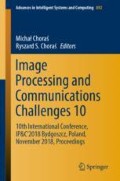Abstract
Because of the increasing requirements in regards to the pipeline transport regulations, the operators take care to the rigorous application of checking routines that ensure nonoccurrence of leaks and failures. In situ pipe inspection systems such as endoscopy, remains a reliable mean to diagnose possible abnormalities in the interior of a pipe such as corrosion. Through digital video processing, the acquired videos and images are analyzed and interpreted to detect the damaged and the risky pipeline areas. Thus, the objective of this work is to bring a powerful analysis tool for a rigorous pipeline inspection through the implementation of specific algorithms dedicated to this application for a precise delimitation of the defective zones and a reliable interpretation of the defect implicated, in spite of the drastic conditions inherent to the evolution of the endoscope inside the pipeline and the quality of the acquired images and videos.
Access this chapter
Tax calculation will be finalised at checkout
Purchases are for personal use only
References
The free dictionary by Farlex. http://www.thefreedictionary.com/corrosion
Yasir, M.: Introduction to FPGA Technology (2011). Website FPGA related.com, https://www.fpgarelated.com/showarticle/17.php
Soler, L., Malandrin, G., Delingette, H.: Segmentation automatique: application aux angioscanners 3D du foie. Traitement de Signal 15(5), 411–431 (1998)
Lee, S.U., Chung, S.Y., Park, R.H.: A comparative performance study of several global thresholding techniques for segmentation. Comput. Vis. Graph. Image Process. 52, 17–190 (1990)
Sezgin, M., Sankur, B.: Survey over image thresholding techniques and quantitative performance evaluation. J. Electron. Imaging 13(1), 146–165 (2004)
Sauvola, J., Pietikakinen, M.: Adaptive document image binarization. Pattern Recogn. 33(2), 225–236 (2000)
Niblack, W.: Introduction to Digital Image Processing. Prentice Hall (1986)
Feng, M.L., Tan, Y.P.: Contrast adaptive binarization of low quality document images. IEICE Electron. Express 1(16), 501–506 (2004)
Wolf, C., Jolion, J.M.: Extraction and recognition of artificial text in multimedia documents. Pattern Anal. Appl. 6(4), 309–326 (2004)
Shafait, F., Keysers, D., Breuel, T.M.: Efficient implementation of local adaptive thresholding techniques using integral images. In: Document Recognition and Retrieval XV, Proceedings of SPIE, San Jose, CA, vol. 6815 (2008)
Crow, F.: Summed-area tables for texture mapping. ACM SIGGRAPH Comput. Graph. 18, 207–212 (1984)
Viola, P., Jones, M.: Rapid object detection using a boosted cascade of simple features. In: Proceedings of IEEE Computer Society Conference on Computer Vision and Pattern Recognition, Kauai, HI, USA, pp. 511–518 (2001)
Levine, M.D., Nazif, A.M.: Dynamic Measurement of Computer Generated Image Segmentations. IEEE Transactions on Pattern Analysis and Machine Intelligence 7(2), 155–164 (1985)
Acknowledgments
This research was supported by CRTI as part of technological development of research products with a socio-economic impact. We thank all the team members of project “Pipeline Inspection by Endoscopy” who have participated in the realization of the “Endoscope” which make possible the acquiring of video sequences in pipeline and then their processing: the subject of the study in this paper.
Author information
Authors and Affiliations
Corresponding author
Editor information
Editors and Affiliations
Rights and permissions
Copyright information
© 2019 Springer Nature Switzerland AG
About this paper
Cite this paper
Nacereddine, N., Boulmerka, A., Mhamda, N. (2019). Video Processing and Analysis for Endoscopy-Based Internal Pipeline Inspection. In: Choraś, M., Choraś, R. (eds) Image Processing and Communications Challenges 10. IP&C 2018. Advances in Intelligent Systems and Computing, vol 892. Springer, Cham. https://doi.org/10.1007/978-3-030-03658-4_6
Download citation
DOI: https://doi.org/10.1007/978-3-030-03658-4_6
Published:
Publisher Name: Springer, Cham
Print ISBN: 978-3-030-03657-7
Online ISBN: 978-3-030-03658-4
eBook Packages: Intelligent Technologies and RoboticsIntelligent Technologies and Robotics (R0)

